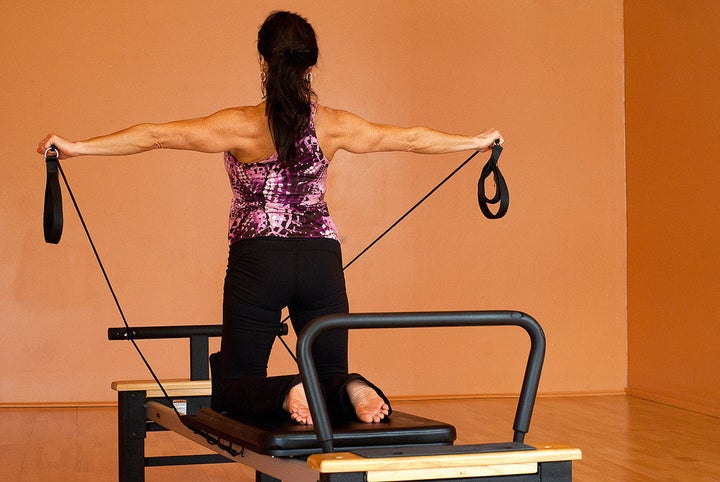
Here's a bold statement: If everyone Post 50 and postpartum did pilates, we'd all be stronger, leaner and more agile; breathe better; stand better; be more focused and -- who knew? -- have better sex. I stumbled on that last attribute in a piece called "Pilates' Dirty Little Secret" written by "The Huffington Post" blogger and Pilates instructor Corrie McCrae. What's the "dirty" secret? "Pilates makes sex better," McCrae wrote, before elaborating on the unbearable lightness and orgasmic attributes of the pelvic floor exercises that are staples in pilates.
I hadn't thought about that last detail until a friend and recent pilates devotee enthused: "Pilates is the sex of exercise." When I asked her to elaborate, she opined: "I would imagine that anyone performing spread-eagle poses and pelvic thrusts while laying down on a leather bench with stirrups in their feet, lifting rhythmically and concentrating on their 'core,' is going to be reminded of other kinds of pelvic thrusts with out without stirrups. Or, is it just me? It's obvious."
The "stirrups" to which she referred are part of the pilates' Reformer, an ingenious carriage-based machine with pulleys, springs and straps, providing total resistance training that's both extremely difficult and strangely effortless.
"What's not obvious," my friend continued, "is the whole idea of the 'core,' or the idea that our energy comes from the center of our being and that that's the part we want to strengthen. That, to me, is sexual, too. The idea of concentrating on the way the body feels as it does these various movements. Being quiet. Feeling our limitations and seeing how our body changes after being stretched in ways it's never before moved. Whether one is a mind/body devotee or not, one naturally becomes fascinated by the idea, because the act of doing the pilates movements is so totally mind/body connected. You have to concentrate as you're instructed and you have to be totally conscious of what your body is doing and 'thinking.'"
The importance of core strength in pilates and the mind/body connection are undeniable. In this regard pilates is similar to yoga, only far more forgiving and with a lot less attitude, too. William Broad recently took yoga to the task in "The New York Times" in his piece "How Yoga Can Wreck Your Body. Yoga teacher Glenn Black told Broad that both yoga students and experienced yogis "injure themselves in droves because most have underlying physical weaknesses or problems that make serious injury all but inevitable. Instead of doing yoga, 'they need to be doing a specific range of motions for articulation, for organ condition.'"
This may explain why many people discover pilates later in life, after other exercises have failed them, injuries have accrued or "underlying physical weaknesses" have literally settled into their bones. (One of my instructors came to the practice after his body was thrashed by years of professional rugby and his tibia was replaced by a metal rod.)
Personally, I practiced yoga back before it became as commercialized as Starbucks. My knees were a mess at the time and yoga was simply too hard on them. Trying to stand on my head with my legs in lotus position next to a levitating yoga jock wasn't much fun, either. After years of "yogatude" I took my weary knees to pilates for physical therapy and developed a mind/body connection and endurance I hadn't felt since my 20s. (News flash: As pilates becomes more accessible, it also becomes more affordable. Some studios, like the one where I practice, offer $12 community classes and other practical options.)
In terms of the mind/body/sex connection, I have yet to discover the Kama Sutra of pilates but did find more ado about such matters on the web, including Tonya Sheridan's "8 Ways Pilates Improves Your Sex Life" and an "Everything About Pilates" site that featured a piece called "The Secret Ingredients Of How To Have Better Sex Doesn't Come From A Cake Recipe."
I'm not sure what Joseph Pilates would have said about those "secret ingredients" or whether he kept that "dirty little secret" to himself. Born in Germany, Pilates was a Jack LaLanne of his time -- a health and fitness fanatic who invented his system of physical training in the early 20th century when the air du temps wasn't particularly open-minded about sex. Back then he called his system "contrology," because control is one of six essential principles in pilates. (The other five are centering, flow, breath, precision and concentration.)
Sex aside, Joseph Pilates did have much to say about the relationship between physical well-being and age. Somewhat presciently, back when people's life spans were half what they are today, he wrote: "We retire too early and we die too young, our prime of life should be in the 70's and old age should not come until we're almost 100." Pilates didn't make it to 100, but he did live a strong, vigorous 84 years. His name and legacy, however, live on.
(Photo courtesy of Robert Bejil Photography)
If you're considering trying pilates, check out the slideshow below to learn about pilates' basics and health benefits.
